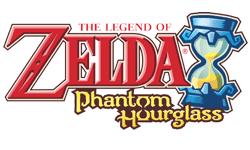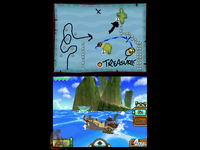|
|

|
PLATFORM
|
DS
|
|
|
BATTLE SYSTEM
|

|
INTERACTION
|

|
ORIGINALITY
|

|
STORY
|

|
MUSIC & SOUND
|

|
VISUALS
|

|
CHALLENGE
|
Easy
|
COMPLETION TIME
|
10-25 hours
|
|
OVERALL

|
Rating definitions
|
|
|
The Nintendo DS hit shelves in North America on November 21, 2004. Though it is typical for the first Zelda title to arrive early in a system's lifespan, fans of the series have had to endure nearly three years to get their hands, quite literally, on Link for his newest adventure. The Legend of Zelda: Phantom Hourglass is the direct sequel to the GameCube's first Zelda, Wind Waker. Beginning with a nicely drawn recapping of the previous game's story, Phantom Hourglass gives players the "Reader's Digest" version of the plot to set the stage and then quickly turns in a different direction altogether to start a new adventure that is mostly unrelated to any of the previous Zelda lore.
The game begins with Link and Tetra searching for, and quickly finding, a ghost ship that is rumored to hold great treasure. Tetra leaps to the other boat to find said loot and then lets out a loud scream. Link attempts to jump to the other ship to save her, but he falls short and wakes up on the beaches of Mercay Island some time later. While afloat, it seems that Link lost all of his equipment and doesn't even have a single weapon when he comes to. He is quickly greeted by a fairy named Ciela and an old man that calls himself Oshus. Link and Ciela then take a sword from the old man's storage room and embark on a quest to save Tetra. This brings them to a shifty sea captain named Linebeck that is a legend in his own mind. The three set off to explore the seas and uncover their mysteries and treasures.
The single most important aspect of Phantom Hourglass is the battle system. It uses the stylus exclusively for movement and attack. The buttons only perform shortcuts like bringing up the map or switching to the equipped weapon, but everything can be accessed by touching various places on the screen. This touch interface is the best part of the game, because controlling Link has never been so precise. But it does not come without a few problems. Inevitably, attempting to flee from a monster will result in opening the item selection menu while Link gets hit at least a couple times, and considering there are monsters that can kill in one hit, the results can be disastrous. Also, if two things are close by, it can be difficult to select an action. If a pot is close to an enemy, Link may inadvertently pick up the pot instead of striking the monster. Despite the frustration these things may cause, they happen pretty infrequently and they are easily forgiven. The only major drawback to the control scheme that persists through the entire game is that players will necessarily have to have their hand covering part of the screen at all times. The visuals are quite pretty, and one would hate to miss seeing something because a hand was in the way.
Despite those drawbacks, combat in Phantom Hourglass is easy and intuitive. Striking a monster is as simple as tapping it. Performing Link's impressive spin slash is as easy as drawing a circle around him. Want to pull a switch? Touch it. Throw a pot? Tap it, then point to where you want it thrown. Battling enemies has never been easier, and the touch system allows for some great minigames that will challenge even the most dextrous of players.
 Little known fact: Before deciding on becoming the hero of time, Link had a career as a champion trick boomerangist.
Little known fact: Before deciding on becoming the hero of time, Link had a career as a champion trick boomerangist.
|
|
Sadly, Phantom Hourglass doesn't add any new items aside from the titular Phantom Hourglass, but it makes up for the short list of weapons and tools by allowing players to use the touch screen to direct everything. For instance, when using the boomerang, players can literally draw the path that they wish for it to fly. Want it to fly around a corner then fly in a tight circular pattern for an enemy to walk into? If you can draw it, it can be done. If you've ever been frustrated with making a bomb go exactly where you want it to go, Phantom Hourglass will not disappoint; they are thrown with pinpoint precision and land exactly where the stylus tells them to. This level of control applies to each and every weapon, breathing much needed life into a small list of items that would be very stale otherwise. Though it would be nice to have the option to use the d-pad to move around, nothing short of a few hand cramps will slow down most adventurers as they steadily progress through the story.
As stated before, Phantom Hourglass is the sequel to Wind Waker. To maintain the connection to Link's adventure on the Cube, the same cel-shaded graphical style is used. Considering the DS is not quite as powerful as its disc-based cousin, the graphics are understandably less detailed, but they are definitely some of the best the DS has produced to date. The world is vibrant and colorful, and it is especially impressive when on the sea. Considering the world is still flooded, much of Link's travels are again by boat. Impressively, far off islands are visible from almost any place on the map, so long as Link is in the proper quadrant. To keep the draw distance manageable, the player can only navigate one-fourth of the sea at a time.
Battle isn't the only thing made easier this time around; sea travel has been simplified to drawing a course on the map and having the S.S. Linebeck follow it. Assuming you have a sea chart of one of the other two adjacent pieces of the world, simply sailing to the edge will allow Link to move to the next quadrant. Aquatic combat is managed by tapping the stylus on enemies to fire unlimited cannonballs at foes.
On both land and sea, the screen is divided in two with the action happening in the lower half and a map on the top. The map becomes one of the key components of the game. At almost any point, the player can scribble notes on the map, be them the location of a chest, or the solution to a puzzle. As if the graphics weren't impressive enough, they are stepped up a notch during the boss battles. All but one of the fights take up both screens to produce some of the most epic boss encounters in the series.
 Step 1: Hire a child to draw your map for you. Step 2: Drive the boat in so many circles you get sick. Step 3: Find treasure. Step 4: Profit.
Step 1: Hire a child to draw your map for you. Step 2: Drive the boat in so many circles you get sick. Step 3: Find treasure. Step 4: Profit.
|
|
The one area that Zelda games are almost universally expected to excel in is aurally, and this one is no exception. Despite only adding a few new tunes to the mix, the list of familiar songs that keep popping up in the games are beautifully done. The speakers on the DS do not do it justice; to truly experience the music, it is recommended that the player use a good set of headphones. Not only will that immerse you in the well-crafted score, but it will also help prevent your playing from disturbing others. But wearing headphones won't completely keep you from bothering others; there are several instances in the game where the player is asked to shout into the microphone. That is one of the several ways Phantom Hourglass uses every single DS function available to the system.
Compared to recent entries to the series, this game is much easier. There are no dungeons that are hard to figure out, and it is more or less linear. Should Link lose his way, a fortune teller will gladly point him in the right direction. Most dungeons will take less than thirty minutes to finish with one exception: the Temple of the Ocean King. Though any individual trip down will not take very long, every time the player leaves the temple, every trap, lock, key, and switch will be reset, meaning subsequent visits will require repeating everything done to that point. Granted, each trek down the temple's depths will be aided by the acquisition of new items to speed the process, but it's still annoying. One can only assume it is an artificial way of increasing playtime. It wouldn't be a big deal, but this is where the Phantom Hourglass comes into play. An evil force drains the life out of those that enter the dungeon, and only by using the Sand of Hours can one postpone a slow death below. Since every trip down there is literally a race against the clock, needing to resolve puzzles is a drag, even if they don't take that much time to finish. Many players can expect to flounder during their initial trip into new territory only to eventually run out of time and die. Fortunately, that is usually enough time to figure everything out, so the second trip generally runs smoothly.
The Zelda series has never really been known for being chock full of deep, twisting stories, so it's no surprise that Phantom Hourglass is a little short on plot. But that doesn't mean there is a lack of story; Link encounters scores of people that he interacts with while he learns of the mysteries of that particular island. And then there are the occasional short bursts of plot that the series is known for. In the end, it's an enjoyable experience that should feel familiar to fans of the series, but an epic tale it is not. For what story there is, it is told well, and the script is all nicely written and humorous. Linebeck and Ciela get the bulk of the dialogue, and they play their parts admirably. As usual, Link remains silent, save for the traditional grunts and yells that he utters in combat and such.
Though the game loses points for not adding much in the way of new canon or items, Phantom Hourglass more than makes up for it with an original control method that is only possible on the DS; it is so tight, that it should be able to convert anyone that is skeptical of only using the stylus for moving. The result is a very enjoyable game that deserves a place in any Zelda fan's library. Though the game can be completed in around ten to fifteen hours, all the available exploration, minigames to master, and a multiplayer Wi-Fi mode can easily double that. If Nintendo has not proven the point yet, it certainly has done so by now. Touching most certainly IS good.
Review Archives
|









